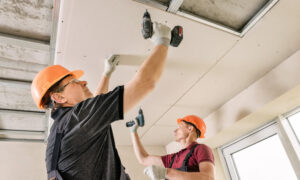Drywall tape contained asbestos for decades. As a result, anyone who worked as a drywall taper prior to the early 1980s could be at risk of cancers like mesothelioma. If you or a loved one are a former drywall taper who has been been diagnosed with mesothelioma, we can help you file for benefits.
Mesothelioma and Drywall Tapers
Mesothelioma is a rare type of cancer caused by breathing in or swallowing fibers from disturbed asbestos. Many tradesmen and construction workers were exposed to asbestos in drywall daily prior to the early 1980s.
Asbestos was used in drywall since it was a good insulator and fire-resistant. It was the drywall tapers’ job to stick together pieces of drywall before sanding them down. This created huge amounts of asbestos dust, putting tapers at risk of mesothelioma.
 This cancer takes 10-50 years to develop after asbestos exposure, so many tapers are just being diagnosed now — including those who served in the military decades ago.
This cancer takes 10-50 years to develop after asbestos exposure, so many tapers are just being diagnosed now — including those who served in the military decades ago.
Thankfully, drywall tapers with mesothelioma may qualify for life-changing medical and financial benefits. Learn more by requesting our Free Veterans Packet.
Why Was Asbestos Used in Drywall Tape?
Before World War II, most walls were made from a time-consuming mix of plaster and wood. Drywall was the solution to this as it allowed more houses to be built in less time. Unfortunately, drywall mixture contained lethal levels of asbestos for decades.
If breathed in or swallowed, these fibers could get trapped in the body and cause mesothelioma decades later.
By 1979, it was estimated that 75,000 U.S. people were employed as drywall tapers. Air samples taken during this period showed that sanders were breathing in fiber concentrations that greatly exceeded government regulations.
Asbestos-based products like drywall tape are now heavily restricted in the U.S. However, many were exposed to asbestos in drywall before the risks became public knowledge in the early 1980s and are still at risk of developing mesothelioma today.
Asbestos in Drywall: High-Risk Job Duties for Workers
Drywall tapers had to perform many tasks as part of their job duties.
Nearly all the steps listed below could kick up asbestos fibers in drywall:
- Covering wallboards with a putty solution
- Filling nail holes with drywall compound
- Sanding the drywall flat
- Blending the joints to create an even surface
- Creating textures for design purposes
- Monitoring and inspecting finished drywalls
Drywall tapers work in dusty environments, so even the workers who weren’t on sanding duty could have been at risk of asbestos exposure simply by breathing in the air around them.
Secondhand Exposure to Asbestos in Drywall
Fibers from asbestos in drywall could easily attach to clothing. If the tapers returned home without sanitizing, they could have unknowingly exposed their families. This is known as secondhand asbestos exposure and can be just as dangerous as being exposed directly.
Spouses, children, and other relatives of drywall tapers could go on to develop mesothelioma as a result of secondhand exposure.
Contact us if you or a loved one has mesothelioma. We can help you access medical care, military benefits, and compensation if eligible.
Present-Day Risks of Asbestos in Drywall
There is no longer any asbestos used in drywall today — instead, it contains gypsum, lime, and cement. Further, drywall tapers typically wear coveralls to reduce the transfer of dust fibers.
 That said, drywall remains a hazard in older buildings that were made before the risks of asbestos were well-known. Whenever older buildings are demolished or renovated, asbestos-containing drywall has to be removed and disposed of safely.
That said, drywall remains a hazard in older buildings that were made before the risks of asbestos were well-known. Whenever older buildings are demolished or renovated, asbestos-containing drywall has to be removed and disposed of safely.
Today, specialized asbestos teams are often called in to inspect the area and make recommendations to drywall tapers before work begins.
Compensation for Drywall Tapers With Mesothelioma
Millions of Americans, including many drywall tapers, were exposed to asbestos before the risks were public knowledge. Thousands of people develop mesothelioma every year as a result.
Makers of asbestos-based products knew the risks of asbestos in drywall and other products as far back as the 1930s but hid the truth to keep their profits high. Fortunately, you may qualify for financial and medical benefits if you develop mesothelioma from asbestos in drywall.
You can get help through:
Mesothelioma Lawsuits
Filing a mesothelioma lawsuit or claim against the makers of asbestos-containing drywall tape can allow you to get financial compensation. The average mesothelioma claim pays out over $1 million.
Money secured from a mesothelioma lawsuit can help you and your family pay for anything — including treatment costs and household expenses.
Asbestos Trust Funds
Many manufacturers of asbestos-based products filed for bankruptcy protection after the risks of asbestos became well-known. These bankrupt companies were forced to put money aside in asbestos trust funds for those who were harmed.
You can't file a mesothelioma claim against companies with trust funds. Instead, you'll need to file a trust fund claim. More than $30 billion is currently available across all asbestos trusts.
We can help you file an asbestos trust fund claim right now.
VA Benefits
Military construction workers may have been exposed to asbestos in drywall on a regular basis. If you are a U.S. veteran with mesothelioma, you may qualify to get benefits from the U.S. Department of Veterans Affairs (VA).
Mesothelioma VA benefits typically pay out almost $4,000 each month. Further, you can also get care from top mesothelioma doctors who work with the VA for free or at a low cost.
File for mesothelioma VA benefits now with help from Eric Hall, our VA-accredited attorney and a fellow U.S. veteran.
Help for Drywall Tapers Exposed to Asbestos
Asbestos in drywall has led to the deaths of far too many Americans — including civilians and U.S. veterans. If you or a loved one was exposed to asbestos in drywall and later got sick, the Mesothelioma Veterans Center is standing by to help you.
Our team can connect you with:
- Financial compensation
- Top doctors & medical care
- VA benefits
Learn about all the ways we can help you in our Free Veterans Packet.
Asbestos in Drywall Tape FAQs
How to tell if your drywall has asbestos?
You won't be able to tell if drywall has asbestos by looking at it. You'll need to consult an asbestos abatement professional and get it tested.
If the asbestos drywall is not deteriorating and is in good shape, it may be safe to remain in your house as it won't pose a threat to your health.
However, you can always get it safely removed as a precaution by working with abatement professionals.
How much asbestos is in drywall mud?
Drywall mud, tape, and joint compound contained between 3% and 15% asbestos by weight, according to a 2019 report published in Critical Reviews in Toxicology.
Working with these products could put you or your loved ones at risk of exposure and mesothelioma in the present day.
Call (877) 450-8973 for help if you or a loved one has mesothelioma.
How common was asbestos in plaster?
Asbestos was commonly used in drywall plaster and drywall tape for decades. Thousands of buildings may have used asbestos-containing plaster between the 1930s and early 1980s.
To learn if there is asbestos in the drywall or plaster of your house or another structure, contact a licensed professional.
Don't try to handle the materials in question yourself, as this could release asbestos fibers into the air.
Why was asbestos used in drywall?
Asbestos was used in drywall because it was very durable and heat-resistant. Using asbestos also allowed drywall to be made faster than mixing wood and plaster.
Further, the dangers of asbestos weren't fully known until the early 1980s. Thus, it was believed that asbestos was safe to use in drywall — even though we now know it causes mesothelioma.
How can I get help if I was exposed to asbestos in drywall?
If you were exposed to asbestos in drywall and now have mesothelioma, you can get help by contacting our team.
We can connect you with medical care from top doctors, financial aid often worth $1 million or more, and monthly VA benefits if you qualify.
If you were exposed to asbestos but aren't yet sick, keep a watch out for possible symptoms of asbestos-related diseases (like a cough or shortness of breath) and see a doctor quickly if they appear.
Can you put drywall over asbestos?
Do not try to put drywall over any materials in your home that may contain asbestos yourself.
Instead, call an asbestos abatement professional who can assess the products in question and recommend tips to keep you and your family safe.


